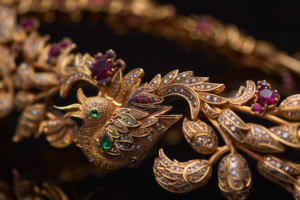Gold jewellery offers a unique blend of beauty and investment potential. Explore its historical and cultural significance, understand the factors influencing its value, and learn how to buy and sell gold jewellery wisely. Whether purchasing gold jewellery for special occasions or as a long-term investment, this guide will provide valuable insights.

Throughout history, gold has been heralded for its intrinsic value and beauty. Its allure transcends mere physical properties, encompassing emotional and cultural significance. This precious metal has been pivotal in human civilisation, making it more than just a commodity. Whether buying gold jewellery in India or considering a long-term investment, it remains a popular choice. Additionally, gold jewellery for special occasions can be a beautiful way to celebrate, while buying gold jewellery for investment purposes ensures you make a wise financial decision.
The Historical Significance of Gold
Gold has been treasured for thousands of years, serving as a medium of exchange, a symbol of wealth, and an object of artistic expression. Ancient civilisations used gold in coinage, religious artefacts, and personal adornments, often signifying status and power. Today, historical significance motivates people to buy gold jewellery to preserve wealth and legacy.
Today, gold has been viewed as a hedge against economic instability. Investors often turn to gold during times of inflation or geopolitical turmoil. Its value maintenance history gives many people confidence in its continuing relevance in the financial landscape, making it a wise investment for those considering buying gold jewellery for investment purposes. Its enduring appeal remains strong whether for personal use or as a long-term investment.
The Cultural Importance of Gold Jewellery
Gold jewellery holds immense cultural significance in various societies around the world. In many cultures, it is customary to gift gold jewellery during important life events such as weddings, births, and religious ceremonies. The beauty and durability of gold make it an eternal token of love, prosperity, and tradition.
Moreover, local craftsmanship adds a unique flair, reflecting a region's cultural heritage. For example, intricate designs in Indian gold jewellery often feature detailed engravings and gemstone inlays. At the same time, minimalist Scandinavian pieces focus on simplicity and elegance. This cultural diversity plays a significant role in the global appeal of gold jewellery as an investment.
In addition to its aesthetic and economic value, gold jewellery often carries stories and memories, becoming a cherished heirloom passed down through generations. Each piece can encapsulate personal histories, making them adornments and vessels of familial legacy. In many cultures, gifting gold jewellery is imbued with deep meaning, symbolising wealth and the bonds of love and commitment that connect families and communities.
Furthermore, the resurgence of interest in sustainable and ethically sourced gold has prompted a new wave of awareness regarding the environmental and social implications of gold mining. Consumers increasingly seek gold jewellery for special occasions that align with their values, opting for pieces crafted from recycled materials or sourced from mines that adhere to ethical practices. This shift not only enhances the allure of gold jewellery but also ensures that its legacy is preserved in a manner that respects both people and the planet.

The Basics of Investing in Gold Jewellery
Investing in gold jewellery requires a solid understanding of the market dynamics and the types of jewellery available. Unlike investment-grade gold, which often refers to bullion, gold jewelry can vary widely in value based on design, craftsmanship, and market demand.
Types of Gold Jewellery Investments
Investors can choose from several categories when considering gold jewellery investments. These include vintage and antique pieces, contemporary designer jewellery, and custom-made items. Each type carries a unique value proposition:
Vintage and antique pieces: Often sourced from historical periods, these items may be appreciated due to their rarity and craftsmanship.
Designer jewellery: Renowned designers often command a premium, making their pieces valuable for the gold content and the brand's prestige.
Custom-made jewellery: Custom pieces can be uniquely crafted to meet specific tastes, often resulting in one-of-a-kind creations that hold personal value and resale potential.
Assessing the Value of Gold Jewellery
Determining the value of gold jewellery involves several factors, understanding gold purity and hallmarks in jewellery, the craftsmanship, and any additional gemstones or materials used. The gold content is measured in karats, with 24 karats representing pure gold. Higher karat counts typically translate to a higher value.
Additionally, appraisals by certified gemologists can provide insights into an item's worth. When considering an investment, it's wise to consult market trends and recent sales of similar pieces to gauge potential appreciation over time.
Moreover, a piece's provenance can significantly enhance its value. Items with a documented history, such as those previously owned by notable figures or featured in prestigious exhibitions, often attract collectors and investors alike. This historical context can create a narrative that adds to the allure of the jewellery, making it not just an investment but a conversation starter and a piece of art.
Furthermore, the jewellery's condition plays a crucial role in its valuation. Well-maintained pieces, free from significant wear or damage, are more likely to fetch higher prices. Regular maintenance and careful storage can preserve the integrity of gold jewellery, ensuring that it remains a sound investment. As trends in fashion and design evolve, staying informed about popular styles can also guide investors in selecting pieces that may appreciate value over time.

The Pros and Cons of Investing in Gold Jewellery
As with any investment, there are advantages and disadvantages to investing in gold jewellery. Understanding these can help investors make informed decisions tailored to their financial goals, whether they are considering buying gold jewellery for investment or simply looking to buy it for personal use.
The Benefits of Gold Jewellery as an Investment
One of the primary benefits of investing in gold jewellery is its dual nature as both an asset and a luxury item. Unlike standard financial investments, gold jewellery offers aesthetic appeal and can be worn and enjoyed. This versatility can also be seen as a hedge against inflation, providing safety during rampant economic changes. Additionally, gold jewellery has historically maintained its value. When market securities falter, the allure of gold often holds steadily, making it a popular choice for wealth preservation.
Potential Drawbacks to Consider
Despite its many advantages, investing in gold jewellery has drawbacks. Firstly, the market can be unpredictable, and not all pieces are appreciated. Furthermore, liquidity can be a concern; selling jewellery may take longer than selling gold bullion due to the need to find the right buyer. Lastly, the purchase price often includes the value of gold and the cost of craftsmanship and design. While this can add value, it also means that an item must be appraised thoughtfully to assess its true investment potential.

Key Factors Influencing Gold Jewellery Prices
The price of gold jewellery is subject to various influences, making it critical for investors to stay informed about market trends and other external factors. Understanding these can help anticipate price fluctuations.
The Impact of Global Market Conditions
Gold prices are heavily tied to global market conditions. Economic indicators such as inflation rates, currency values, and geopolitical events can influence gold demand. For instance, during periods of financial uncertainty, gold often sees a surge in demand, leading to increased prices. Additionally, factors such as the strength of the US dollar and shifts in interest rates also directly impact gold prices, as investors may turn to gold as a safe haven during volatile times.
The Role of Craftsmanship and Design
Another significant factor influencing the price of gold jewellery is the level of craftsmanship and design involved. High-quality craftsmanship often demands higher prices due to the time and skill required to create intricate details. This is especially true for handmade or designer pieces, which can carry a premium over mass-produced items. Market trends also shift, and certain styles or eras may gain popularity, affecting demand and prices for specific types of gold jewellery. Being attuned to these aesthetic shifts can empower investors in their purchasing decisions.

Practical Tips for Investing in Gold Jewellery
Embarking on an investment in gold jewellery can be rewarding if approached with a strategy. Ensuring you have the correct information before buying gold jewellery will help maximise your investment's potential. Whether looking to buy gold jewellery for personal enjoyment or as a financial asset, being well-informed is crucial in making sound decisions.
Where to Buy Gold Jewellery
Identifying trustworthy places to buy gold jewellery is essential. Reputable jewellers, auction houses, and online marketplaces can be good options. When purchasing, look for sellers who provide certifications and detailed appraisals, ensuring the authenticity and value of the jewellery. Moreover, attending jewellery shows or estate sales can offer opportunities to find unique pieces, often at competitive prices. Remember to research sellers and their histories to ensure legitimacy.
How to Store and Insure Your Investment
Proper storage of gold jewellery is crucial to maintaining its condition and value. To prevent scratches and damage, store pieces in a cool, dry place, ideally in a soft cloth or padded box. Additionally, consider using a safe deposit box for high-value items.
Insurance is another vital component of protecting your investment. Speak to an insurance agent about policies that specifically cover jewellery. An accurate appraisal will facilitate insurance claims in case of loss or damage, providing added peace of mind.
In conclusion, investing in gold jewellery can be a lucrative and fulfilling decision. By understanding its allure, the investment landscape, and practical considerations, investors can approach this endeavour equipped with the necessary knowledge for success.





Article
Investing in Gold Jewellery: What You Need to Know
Gold jewellery is more than just an accessory; it's a valuable asset with cultural and historical significance. Discover the factors influencing gold prices, learn how to assess the value of gold jewellery, and explore the pros and cons of investing in this precious metal.